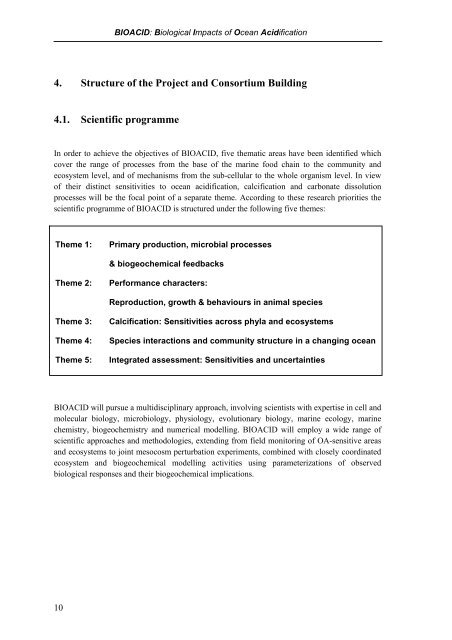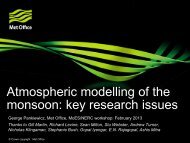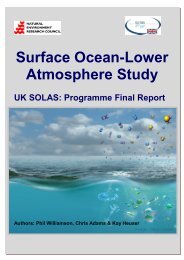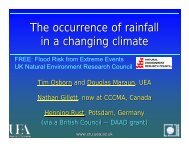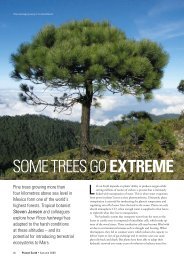- Page 1 and 2: BIOACID A proposed national ‘Verb
- Page 3 and 4: BIOACID: Biological Impacts of Ocea
- Page 5 and 6: Summary BIOACID: Biological Impacts
- Page 7 and 8: BIOACID: Biological Impacts of Ocea
- Page 9: BIOACID: Biological Impacts of Ocea
- Page 13 and 14: BIOACID: Biological Impacts of Ocea
- Page 15 and 16: BIOACID: Biological Impacts of Ocea
- Page 17 and 18: BIOACID: Biological Impacts of Ocea
- Page 19 and 20: BIOACID: Biological Impacts of Ocea
- Page 21 and 22: BIOACID: Biological Impacts of Ocea
- Page 23 and 24: BIOACID: Biological Impacts of Ocea
- Page 25 and 26: BIOACID: Biological Impacts of Ocea
- Page 27 and 28: BIOACID: Biological Impacts of Ocea
- Page 29 and 30: BIOACID: Biological Impacts of Ocea
- Page 31 and 32: BIOACID: Biological Impacts of Ocea
- Page 33 and 34: Table 4: Training workshops BIOACID
- Page 35 and 36: BIOACID: Biological Impacts of Ocea
- Page 37 and 38: BIOACID: Biological Impacts of Ocea
- Page 39 and 40: BIOACID: Biological Impacts of Ocea
- Page 41 and 42: BIOACID: Biological Impacts of Ocea
- Page 43 and 44: BIOACID: Biological Impacts of Ocea
- Page 45 and 46: BIOACID: Biological Impacts of Ocea
- Page 47 and 48: BIOACID: Biological Impacts of Ocea
- Page 49 and 50: BIOACID: Biological Impacts of Ocea
- Page 51 and 52: BIOACID: Biological Impacts of Ocea
- Page 53 and 54: Signal BIOACID: Biological Impacts
- Page 55 and 56: BIOACID: Biological Impacts of Ocea
- Page 57 and 58: BIOACID: Biological Impacts of Ocea
- Page 59 and 60: BIOACID: Biological Impacts of Ocea
- Page 61 and 62:
BIOACID: Biological Impacts of Ocea
- Page 63 and 64:
BIOACID: Biological Impacts of Ocea
- Page 65 and 66:
BIOACID: Biological Impacts of Ocea
- Page 67 and 68:
BIOACID: Biological Impacts of Ocea
- Page 69 and 70:
BIOACID: Biological Impacts of Ocea
- Page 71 and 72:
BIOACID: Biological Impacts of Ocea
- Page 73 and 74:
BIOACID: Biological Impacts of Ocea
- Page 75 and 76:
BIOACID: Biological Impacts of Ocea
- Page 77 and 78:
BIOACID: Biological Impacts of Ocea
- Page 79 and 80:
BIOACID: Biological Impacts of Ocea
- Page 81 and 82:
Work Schedule BIOACID: Biological I
- Page 83 and 84:
1.1.4 PhD (Reusch) 1.1.4 Tech (Rieb
- Page 85 and 86:
Budget justification 1.1.4. BIOACID
- Page 87 and 88:
BIOACID: Biological Impacts of Ocea
- Page 89 and 90:
BIOACID: Biological Impacts of Ocea
- Page 91 and 92:
Work Schedule 1.2.2 BIOACID: Biolog
- Page 93 and 94:
BIOACID: Biological Impacts of Ocea
- Page 95 and 96:
1.2.5 Subtotal Consumables 1.2.1 1.
- Page 97 and 98:
BIOACID: Biological Impacts of Ocea
- Page 99 and 100:
BIOACID: Biological Impacts of Ocea
- Page 101 and 102:
BIOACID: Biological Impacts of Ocea
- Page 103 and 104:
BIOACID: Biological Impacts of Ocea
- Page 105 and 106:
BIOACID: Biological Impacts of Ocea
- Page 107 and 108:
BIOACID: Biological Impacts of Ocea
- Page 109 and 110:
BIOACID: Biological Impacts of Ocea
- Page 111 and 112:
BIOACID: Biological Impacts of Ocea
- Page 113 and 114:
BIOACID: Biological Impacts of Ocea
- Page 115 and 116:
BIOACID: Biological Impacts of Ocea
- Page 117 and 118:
BIOACID: Biological Impacts of Ocea
- Page 119 and 120:
vi. References BIOACID: Biological
- Page 121 and 122:
BIOACID: Biological Impacts of Ocea
- Page 123 and 124:
BIOACID: Biological Impacts of Ocea
- Page 125 and 126:
BIOACID: Biological Impacts of Ocea
- Page 127 and 128:
BIOACID: Biological Impacts of Ocea
- Page 129 and 130:
BIOACID: Biological Impacts of Ocea
- Page 131 and 132:
BIOACID: Biological Impacts of Ocea
- Page 133 and 134:
BIOACID: Biological Impacts of Ocea
- Page 135 and 136:
ii. State of the Art BIOACID: Biolo
- Page 137 and 138:
BIOACID: Biological Impacts of Ocea
- Page 139 and 140:
Schedule BIOACID: Biological Impact
- Page 141 and 142:
BIOACID: Biological Impacts of Ocea
- Page 143 and 144:
Travel 2.3.1 2.3.2 Subtotal Service
- Page 145 and 146:
BIOACID: Biological Impacts of Ocea
- Page 147 and 148:
BIOACID: Biological Impacts of Ocea
- Page 149 and 150:
ii. State of the Art BIOACID: Biolo
- Page 151 and 152:
BIOACID: Biological Impacts of Ocea
- Page 153 and 154:
BIOACID: Biological Impacts of Ocea
- Page 155 and 156:
BIOACID: Biological Impacts of Ocea
- Page 157 and 158:
BIOACID: Biological Impacts of Ocea
- Page 159 and 160:
BIOACID: Biological Impacts of Ocea
- Page 161 and 162:
BIOACID: Biological Impacts of Ocea
- Page 163 and 164:
BIOACID: Biological Impacts of Ocea
- Page 165 and 166:
BIOACID: Biological Impacts of Ocea
- Page 167 and 168:
BIOACID: Biological Impacts of Ocea
- Page 169 and 170:
BIOACID: Biological Impacts of Ocea
- Page 171 and 172:
BIOACID: Biological Impacts of Ocea
- Page 173 and 174:
BIOACID: Biological Impacts of Ocea
- Page 175 and 176:
BIOACID: Biological Impacts of Ocea
- Page 177 and 178:
BIOACID: Biological Impacts of Ocea
- Page 179 and 180:
3.2.1 3.2.2 3.2.3 3.2.4 Subtotal Tr
- Page 181 and 182:
BIOACID: Biological Impacts of Ocea
- Page 183 and 184:
BIOACID: Biological Impacts of Ocea
- Page 185 and 186:
BIOACID: Biological Impacts of Ocea
- Page 187 and 188:
BIOACID: Biological Impacts of Ocea
- Page 189 and 190:
BIOACID: Biological Impacts of Ocea
- Page 191 and 192:
Consumables 3.3.1 3.3.2 Subtotal Tr
- Page 193 and 194:
BIOACID: Biological Impacts of Ocea
- Page 195 and 196:
BIOACID: Biological Impacts of Ocea
- Page 197 and 198:
Links to other subprojects BIOACID:
- Page 199 and 200:
BIOACID: Biological Impacts of Ocea
- Page 201 and 202:
BIOACID: Biological Impacts of Ocea
- Page 203 and 204:
Subtotal Investments 3.4.1 Gas-mixi
- Page 205 and 206:
vi. References BIOACID: Biological
- Page 207 and 208:
BIOACID: Biological Impacts of Ocea
- Page 209 and 210:
BIOACID: Biological Impacts of Ocea
- Page 211 and 212:
Milestones (3.5.1) BIOACID: Biologi
- Page 213 and 214:
Milestones (3.5.2) BIOACID: Biologi
- Page 215 and 216:
BIOACID: Biological Impacts of Ocea
- Page 217 and 218:
3.5.3 BIOACID: Biological Impacts o
- Page 219 and 220:
BIOACID: Biological Impacts of Ocea
- Page 221 and 222:
C:N Ratio (molar) Respiration (µg
- Page 223 and 224:
BIOACID: Biological Impacts of Ocea
- Page 225 and 226:
BIOACID: Biological Impacts of Ocea
- Page 227 and 228:
BIOACID: Biological Impacts of Ocea
- Page 229 and 230:
BIOACID: Biological Impacts of Ocea
- Page 231 and 232:
BIOACID: Biological Impacts of Ocea
- Page 233 and 234:
BIOACID: Biological Impacts of Ocea
- Page 235 and 236:
Budget justification 4.1.1 BIOACID:
- Page 237 and 238:
BIOACID: Biological Impacts of Ocea
- Page 239 and 240:
BIOACID: Biological Impacts of Ocea
- Page 241 and 242:
BIOACID: Biological Impacts of Ocea
- Page 243 and 244:
BIOACID: Biological Impacts of Ocea
- Page 245 and 246:
BIOACID: Biological Impacts of Ocea
- Page 247 and 248:
BIOACID: Biological Impacts of Ocea
- Page 249 and 250:
BIOACID: Biological Impacts of Ocea
- Page 251 and 252:
BIOACID: Biological Impacts of Ocea
- Page 253 and 254:
BIOACID: Biological Impacts of Ocea
- Page 255 and 256:
BIOACID: Biological Impacts of Ocea
- Page 257 and 258:
BIOACID: Biological Impacts of Ocea
- Page 259 and 260:
5.2.d Subtotal Investments Subtotal
- Page 261 and 262:
BIOACID: Biological Impacts of Ocea
- Page 263 and 264:
BIOACID: Biological Impacts of Ocea
- Page 265 and 266:
Theme Project and data management,
- Page 267 and 268:
Theme Theme Leader BIOACID: Biologi
- Page 269 and 270:
Theme Theme Leader BIOACID: Biologi
- Page 271 and 272:
Theme Theme Leader BIOACID: Biologi
- Page 273 and 274:
Species Theme interactions and comm
- Page 275 and 276:
Theme Integrated assessment: Sensit
- Page 277 and 278:
Appendix: Principal Investigators B


